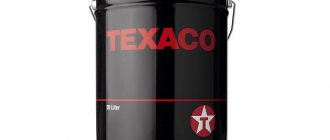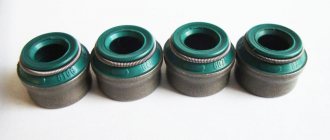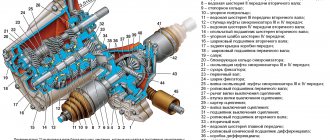SURPRISES
The tests lasted almost six months. Believe me, we have something to show: the summary tables turned out to be so huge that they would be more suitable for a dissertation than for a journal article. Therefore, the results were separated for each sample separately. But we won’t compare oils and give out seats - that’s not the purpose of the tests. But some general conclusions are immediately apparent.
So, the first phenomenon. The viscosity of all oils during long-term idle operation up to a certain point is significantly less than during “highway driving”. Why? We believe that when the engine is idling (and this is not as stable a mode as at operating, higher speeds), the passage of exhaust gases into the crankcase increases, and with them, unburned fuel mixing with oil. This is confirmed by the fact that the flash point drops at the same time, and this is one of the main signs of the presence of fuel in the oil.
The drop in viscosity is 0.4...0.6 cSt. Is it a lot or a little? For the bulk of oils, this does not mean crossing the lower limit of the viscosity class and is about 5...6% of the average level. But with the “twenties” the percentage will be greater. However, we will try to verify these assumptions during the following examinations.
Further - more interesting. Starting from a certain operating time in idling mode (70...100 engine hours), the viscosity begins to increase sharply, ahead of the “highway” cycle indicator - the oil ages before our eyes. Why? Most likely due to prolonged contact with products of incomplete combustion that have a certain acidity. Here's the result of driving through traffic jams! Idling is affected by poor ventilation of the combustion chamber due to the closed throttle valve, and low turbulence of the air-fuel mixture due to the relatively slow movement of the piston. Hence the poor combustion rate. But the passage of gases into the crankcase, as already mentioned above, is maximum.
This dynamics is not the same for different oils. It is less pronounced for ZIC XQ, Shell Helix, Motul X-cess and much more noticeable for Esso Ultron and BP Visco. We look at the results of the previous test - and on the “highway” the picture of changes in viscosity for the same oils was similar.
By the way, it seems to us that the situation is aggravated by elevated oil temperatures in the sump during idle mode. We also wrote about the dangers of volumetric overheating earlier (ZR, 2013 No. 3), and here we see new confirmation of this hypothesis. We did not reach complete polymerization in any experiment, but for some oils the dynamics of viscosity growth was quite unpleasant.
Check the condition of the oil often!
Practical application of the technique.
Refusal to determine the replacement interval based on mileage can be considered justified. The question arises about the practical implementation of alternative methods.
An option to accurately determine the need to change the lubricant is laboratory testing. Unfortunately, this method is not very suitable for practice. Automakers and car owners have to use averaged indirect methods.
Again about the manufacturers' proposals.
In modern cars, calculating the intervals between replacements is easy to implement on the ECU. Car manufacturing companies solve the issue in various ways:
- By fuel consumption. But consumption depends on many factors, and the aging of lubricants is affected by the completeness of combustion. In short, algorithmization is difficult.
- By average speed. Simple average method. The accuracy is not defined, but the logic is clear. Suitable for use by car owners without using an on-board computer.
- Based on operating time in XX mode. It is also a fairly logical technique, but the accuracy is inferior to the previous one.
- By the number of engine starts, etc.
In general, the problem of calculation turns out to be complex - there are practically no well-developed models of aging of lubricants suitable for algorithmization, and there are no statistics on the quantitative influence of various factors.
As a result, the simplest method with average engine hours turns out to be the most effective. Its additional advantage is the ability to link it to the characteristics of oils.
Lubricant resource.
Information on engine life hours according to API (American Petroleum Institute) for various types of motor lubricants is summarized in the table:
Accordingly, replacement must be made BEFORE the resource is completely exhausted. The task that the car owner needs to solve is calculating engine hours since the last service.
How to use the technique?
The average calculation of engine hours is quite simple if you have an average speed indicator.
M=S/V
Here:
- M – average engine hours;
- S – mileage since the start of measurements;
- V – average speed.
Analysis of the readings should be carried out no less than after 1-2 thousand km of escape (the counter is reset after the next service). This ensures sufficient accuracy.
More often, solving the inverse problem is useful - determining the mileage for replacement (the average person is more familiar with this).
The dependency is converted to the form
S=M*V
Accordingly, with the predominance of the road cycle and an average speed of about 60 km/h, semi-synthetics will have to be replaced after
S = (180..250) * 60 = 10800..15000 km.
The result is in excellent agreement with the usual recommendations of manufacturers.
However, for the urban cycle, where the average speed is 2-3 times less, the interval will be reduced accordingly. It will be about 5-7 thousand km. and exceeding the limits is fraught with problems with the engine.
In a similar way, you can solve the problem of actual consumption.
- Determine the lubricant life from the table;
- Calculate the theoretical total consumption by multiplying the resource by the average consumption on the highway given in the documentation.
- Divide the actual expense by the reference expense.
- Dividing the theoretical consumption by the value obtained in the previous step, obtain the actual number of engine hours.
- It is not difficult to calculate mileage using this method yourself.
terms of Use
Under ideal conditions, the car develops a speed of 40 km/h in the city, we get 15000/40 = 375 engine hours. For a suburban highway we assume 80 km/hour, calculating 15000/80=188 engine hours.
Let's compare the experimentally obtained figure of 576 with the calculated 375, we conclude: the engine operates under difficult operating conditions, to increase its service life it is necessary to change the oil 2 times more often. Many people don’t know: engine fluid replacement is regulated and amounts to:
- 250 operating hours for ACEA E2, API CF, CF-4, CG4;
- 400 - VDS, ACEA E3;
- 600 - for VDS-2.
The service book states that under severe operating conditions, the oil is replaced every 8 thousand kilometers. Such conditions include:
- there is a significant amount of dust in the air;
- long driving at low speed;
- moving a vehicle over mountainous and hilly terrain;
- high temperature outside the car;
- use of fuel of questionable quality;
- frequent changes of gas stations;
- when towing a trailer;
- fully loaded trunk.
If it is not possible to carry out this calculation, experts recommend relying on fuel consumption. For example, a car must consume 9 liters of gasoline or diesel fuel per 100 km in the city, according to the regulations, for 15 thousand kilometers it will be 1350 liters - (15000/100)*9, the real consumption is 11 liters per 100 km, at 15 thousand km will be 1650 liters. It is necessary to change fluids at a volume of 1350 liters. This method is relative.
When answering the question: “How many engine hours should pass before replacing the engine mixture in the engine?”, consider:
- Type of power unit. The temperature inside diesel engines is much higher than in gasoline-powered drives. The lubricant is subjected to heavy loads.
- The engine is under load; as the load increases, the service life of the oil decreases.
- The car drives on a country road or around the city. On the highway, the engine wears out more slowly: it works for a long time with the same load.
Change the mixture according to the engine hours traveled, do not carry out scheduled fluid changes based on the mileage of the car. Use certified products that meet the technical characteristics of the engine, use motor oil that meets the recommendations of the vehicle manufacturer.
Mileage and mixture replacement
The car dealer indicates the period of scheduled maintenance; in my car, the engine fluid must be replaced according to the regulations every 15 thousand km. Let's figure out how many engine hours the engine will last when driving around the city and the engine of a similar car, the owner of which will drive mainly on country roads. Let's calculate whether the declared mileage corresponds to the actual engine oil change period.
The engine hours indicate the duration of operation of the power unit at rated speed; the engine hour is equal to one hour of normal operation of the drive. When performing calculations using engine hours, you do not take into account the operating conditions of the power unit (with a loaded engine, the engine fluid wears out faster and requires replacement).
According to my car's on-board computer, the average speed is 26 km/h. This is a real figure: when getting to work, I have to stand in traffic jams for 40 minutes; in the evening, under similar conditions, the car sits idle for 1.5 hours. With such a variable load, the operating mode of the power unit is close to extreme operating conditions, the drive heats up, the engine mixture experiences a colossal load - at high temperatures it changes its properties. Obviously: you will have to change the fluid before the recommended mileage.
Based on the facts, let’s take 15 thousand km for calculation, divide the indicated mileage by the average speed of the vehicle, we get 15,000/26 = 576 engine hours. This takes into account the time spent in traffic jams, plus warming up the engine in winter (the on-board computer starts counting from the moment the drive starts).
According to the calculations, we obtain the values, put them in table 1
Table 1. Relationship between engine hours, speed and mileage
26
| Speed, km/h | Mileage, thousand km | Engine hours |
| 15 | 576 | |
| 10 | 385 | |
| 8 | 308 |
The average speed in the city is close to 30 km/h, a similar car on a country road will cover a distance 3 times greater, and on the highway the car moves 70 km/h. Both motors will do the same amount of work. The speedometer of the first car will show mileage much less than that of the second car. It is worth considering how realistic the figure indicated by the dealer for replacing the lubricant mixture is.
Oil change timing
The oil change interval mainly depends on the engine type, operating conditions, fuel used (sulfur content in the case of diesel), oil quality level, base oil type, air filter condition, etc. Equipment manufacturers expect that engines will operate in difficult conditions with low fuel quality. Requirements for lubricants and replacement periods are shown in manuals and operating instructions.
Therefore, it can be assumed that motor oils have a reserve of quality and can last longer than specified. Our experience shows that this is possible. A large number of companies have significantly reduced costs with the help of SK's oil change program when using ZIC VHVI engine oils.
Under difficult operating conditions, such as frequent short trips (especially in winter), long periods of engine idling, or dusty conditions (construction and agriculture), oil change times are also reduced. In principle, engine oil should be changed twice a year. This applies to vehicles whose mileage or engine hours are higher than the manufacturer's standard mileage. In this case, an oil change performed in the fall or spring will significantly improve engine reliability.
Operating conditions that shorten the life of oils
- short trips – especially when traveling up to 5 km in winter conditions. Such conditions are favorable for condensation of water and fuel in the engine sump. The greatest wear occurs during engine startup;
- Road dust – dusty working conditions and the use of low quality filters lead to oil contamination, which leads to increased wear. Wear products contribute to the formation of deposits and corrosion from acids;
- engine with high mileage - with a mileage of over 100,000 km, the penetration of crankcase gases, unburned fuel and substances that provoke corrosion into the oil increases;
- use of diesel engines – when operating diesel engines, more soot and acids are produced;
- alternative fuels – when the engine is running on a benzo-ethanol mixture, water may accumulate in the crankcase;
- turbocharged engines - high temperatures negatively affect engine oil and additives;
- high oil consumption - on the one hand, when adding oil, we update its composition, on the other hand, a large amount of crankcase gases penetrates into the crankcase;
- operation at high temperatures - operation in such conditions (desert) can lead to premature oxidation of the oil, volatility and development of additives;
- Extending engine life - shorter oil change periods increase the service life of the engine and its systems;
- towing/carrying heavy loads is the same as operating in high temperatures. In addition, engine operation on thinner oil films, destruction of the thickening additive, high concentration of metals in the oil. All this leads to a decrease in oil life, premature oxidation, and the formation of deposits and acids.
Operating conditions that increase oil change intervals
- synthetic components – have high antioxidant properties, heat resistance and low-temperature properties;
- use of a more efficient oil filter - more effective capture of wear products;
- suburban operation - reducing the negative impact on the engine due to its operation at optimal conditions;
- new engine - lower level of crankcase gases after the first 500-5000 km, but less than 50,000 km;
- Periodically checking the oil condition - a simple check of the oil level can be a very effective measure to prevent malfunctions;
- environmental factor (oil consumption) – emphasis on reducing oil consumption;
- older cars - some owners of low-cost cars prefer to extend oil change intervals
WHAT DO WE CONTROL?
We will judge the patient’s health by changes in basic physical and chemical parameters. This is the dynamics of changes in oil viscosity at different temperatures, alkaline and acid numbers, as well as flash point. The scale is two-level, like “alive - dead”. For example, we consider dead oil the viscosity of which is outside the limits prescribed by the SAE class. In our case, the permissible viscosity range is 12.5...16.3 cSt. A drop in the base number by more than two times from the initial value is a generally accepted rejection parameter; we will also accept it as a conditional criterion for the death of the oil. Another criterion (we have not yet rejected any oil based on it) is the so-called loss of the additive package, which indicates the complete unsuitability of the oil. It is characterized by a sharp (at least threefold) decrease in the concentration of active elements in the oil - zinc, barium, phosphorus - in relation to the initial amount.
As usual, let's check the level of deposits that the oil produces during operation. To do this, let’s estimate their number and color on the side surfaces of the pistons (the so-called analogue of the EPV method). A completely white piston is zero points, an all black piston is six points. Intermediate gradations have their own scores in this interval. All this refers to the so-called high-temperature deposits. And we will evaluate the low-temperature ones quantitatively by weighing the main dirt collectors before and after the tests - the oil pump intake fungus, as well as the oil separator mesh from the valve cover. An increase in the mass of parts will indicate the “degree of sloppiness” of the oil.
The engine wear parameters after the test cycle will help evaluate changes in the protective functions of the oil when operating in the “highway” and “traffic jam” cycles. They can be determined by the content of the main wear products in the oil (for us, the indicator was the presence of iron in it), by accurately weighing the piston rings and crankshaft bearing shells before and after testing.
What determines the frequency of replacement?
Each car manufacturer gives detailed information in its manual about when to change the oil. But this information does not always correspond to real life. Usually in the documents you can see the mileage on average from 10 to 15 thousand km, depending on the brand of the car. But in reality, these numbers are influenced by various factors.
- Quality and type of fuel (diesel, gasoline, gas).
- Engine displacement.
- Type and class of oils used.
- Brand of lubricant poured (mineral, synthetic, semi-synthetic).
- Condition of the engine oil.
- Full mileage.
- Replacement method.
- The quality of the purchased oil.
- Mode and operating conditions.
- Vehicle condition.
The plant’s recommendations are not taken into account in this list, since for them the frequency of replacement is a marketing ploy.
Engine size and type
A powerful motor can more easily withstand heavy loads and difficult working conditions. Therefore, the lubricant will not deteriorate too much. A car with a powerful power unit moving on the road at a speed of 120 km per hour does not put much stress on it.
Subcompact cars are usually equipped with a transmission with a low gear ratio for driving at low speeds and engine speeds. Therefore, in difficult conditions, their motors experience greater load compared to powerful engines. When the load increases, the piston group heats up more, and the volume of gases in the crankcase increases. This increases the temperature of the motor lubricant.
It’s especially difficult for “small cars” with forced 1.2-liter engines. In this case, the load is also added by the turbocharger.
Operating mode
First of all, the frequency of engine lubricant changes is affected by the operating mode of the vehicle. Without going into details of this process, there are two types of modes - urban and suburban. The question is, if the car drives around the city, its mileage will be less, and the load on the power unit will be greater. This is due to frequent downtime in traffic jams and at traffic lights with the engine running. There is not enough cooling.
If the car is used on country roads, the situation is completely different. The mileage is longer, and the engine is cooled much more efficiently. Therefore, the load on the motor and lubrication is also reduced.
It would be more correct to determine when to change the engine oil, taking into account the engine hours. This is done for agricultural and cargo equipment. For example, in a city a car will travel 10,000 km in about 400 engine hours, but the same distance outside the city will take only 100 engine hours. In addition, different operating modes must be taken into account.
It is not for nothing that driving in a big city is equated to rough terrain, as this has a detrimental effect on lubrication. The effect is especially noticeable when the oil level is below average or minimal. In addition, in hot weather there is more load on the oil due to the increased temperature of the air and the road surface.
Other factors
Additional conditions that affect the timing of engine lubricant replacement include high operating temperature. In addition, you need to take into account the characteristics of the oil, the contamination of the oil filter, the condition of the lubrication channels, compliance of the lubricant with the factory recommendations, its originality, and crankcase ventilation.
Note! The optimal time for changing the lubricant is 200-400 operating hours, not counting the maximum load.
In addition, the type of oil plays an important role - synthetic, semi-synthetic, mineral water.
Why change it?
Generally speaking, motor oil is a patient product. And if you create heavenly conditions for it - a clean, brand new engine, medium speeds, low loads (read: operation without overheating), then it will last longer than smart books say. But heaven is where we are not. In real life, oil begins to age literally from the moment it moves from a sealed canister into the labyrinths of the engine. Its oxidation begins, accelerated by constant heating and cooling, detergent additives leave, and dirt accumulates. There is nothing unexpected in all this: the oil must not only lubricate and cool, but also wash the engine, and also remove various impurities from it. But it is quite obvious that the rate of aging of motor oil greatly depends on its operating conditions.
Until recently, it was customary to specifically stipulate “severe operating conditions”, in which the engine oil had to be changed more often than during “normal” driving. This meant, first of all, mountain roads and unpaved roads, driving with a heavy trailer, etc. And then the list was replenished with the most formidable modern horror story - driving in traffic jams.
How often should you change engine oil?
In the first part of the article, we tried to talk about why the quality of motor oil is so important, what happens to it in the bowels of the engine and what factors influence its aging. It remains to talk about how these factors are related to oil change intervals and how often the oils will have to be changed during actual operation.
City and highway
It must be said that changing the oil “by mileage” will almost always be suboptimal. The same mileage on the highway and in city mode means a more than fourfold difference in engine hours and a huge difference in terms of oil degradation. For example, with a standard replacement interval of 15 thousand kilometers, in traffic jams the oil will work for all 700 hours, and on the highway - even less than 200.
For the quality of oil performance, this more than threefold difference is colossal, because even when operating at low load, the thermal effect on the oil is very high. In modern engines, the situation is aggravated by high temperature control, poor crankcase ventilation and lack of crankcase cooling when the car is stuck in traffic jams, which causes a sharp decrease in its service life.
At higher speeds, as the load on the engine increases, the load on the oil also increases. On small engines with a “short” transmission, the engine and oil may already have a very hard time. On more powerful motors the load will increase more smoothly.
Along with the increase in load on the engine, the operating conditions of the oil also worsen: the temperature of the pistons increases, and the flow of destructive crankcase gases begins to increase. Thus, the optimal operating mode for both the oil and the engine is an average speed of half the maximum and a short idle time after warming up.
When calculating engine hours, it turns out that a typical oil change interval of 15 thousand kilometers in engine hours ranges from 200 to 700, depending on the driving mode. Judging by the operation of the scheduled mileage counters on BMW and the oil change intervals on equipment for which the replacement period is indicated precisely in engine hours, during typical operation it can be kept in the range from 200 to 400 hours for different operating modes, with the exception of constant operation in maximum power mode .
Cases of obvious excess when using standard semi-synthetic oils and hydrocracking-based synthetics are fraught with “complications” for the engine in the form of coking and reduced mobility of the piston rings.
.
Well, few of us can boast that we drive cars in the extra-urban cycle at a constant speed. So what to do if the runs are mostly urban, and the engine is also forced? For example, some 1.2 TSI? Obviously, the oil needs to be changed more often.
However, the replacement interval depends not only on the driving mode
It is also important what kind of oil is poured into the engine.
Types of motor oils
The choice of oils in stores is very wide, if not huge. Some of them are not far removed from Soviet mineral oils, some look like a spaceship next to a cart in comparison.
First of all, you need to understand one important thesis: any oil consists of a base and a package of additives. The base can be mineral, semi-synthetic and completely synthetic, in many variations.
Calendar? Odometer? Engine hours? Fuel?
As long as the car is under warranty, it is better to address all “oil” questions to the service technicians. But then everything depends on the operating conditions of the machine. Conventionally, all cars can be divided into three large groups.
A summer resident's car.
The annual mileage is at most a couple of thousand kilometers, mostly from and to the dacha. In general, it almost always stands and only sometimes drives.
Weekend car.
Travels mainly from Friday evening to Sunday evening. As a rule, driving is suburban, the annual mileage is ten to two thousand kilometers.
City employee's car.
He drives every day, constantly getting stuck in traffic jams. The annual mileage is small - about tens of thousands of kilometers.
When is the best time to use engine hours?
The most difficult thing is to calculate the optimal replacement period for the third group, which moves mainly around the city and every day. Low speed, idle time in traffic jams, stop and start mode at traffic lights. That is, the actual mileage may be small, but the engine often idles, which is more harmful to the oil than driving along the highway at a stable speed. In this case, it is unreasonable to focus only on mileage, since in this mode the oil can withstand 5 or 7 thousand, depending on the quality of the lubricant itself, the displacement and the condition of the engine. In this mode, it is recommended to navigate by engine hours. To do this, install an hour meter if the car is not already equipped with one. The device can be connected to any circuit and is powered independently.
Simple arithmetic will help you calculate the optimal number of engine hours. For example, if the recommended mileage from replacement to replacement for your engine is 15,000 km, then at an average speed of 50 km/h this distance will be covered in 300 hours. That is, we take this figure as a basis. I think the calculation is clear, divide the mileage by the average speed and get engine hours. Just plug your numbers into the formula and be guided by the result. On average, it is recommended to set the limit to 200-400 engine hours, but this does not apply to driving with heavy loads - high speeds and revs. The number of engine hours also depends on the type of oil; we will touch on this topic later.
Do not forget that engine hours are not an actual indicator of the time that the engine has been running. The higher the rpm, the faster the counter spins. That is, if you like to race, you will accumulate engine hours much faster, as if you covered the same distance at a lower speed.
How to calculate engine hours?
By the way, on many expensive German foreign cars (for example Mercedes, BMW and others), there is a special counter that counts them. And then it just shows you that you need to go for an oil change, after which it resets to zero and you drive until the next maintenance. That is, there seems to be no exact interval here, AS I THINK THIS IS VERY CORRECT.
German cars often have turbines, the oil wears out even faster because it passes through some components of the turbocharger, removing heat from it and lubricating it, which is why the MOTOR HOURS will be reduced here! Even “top” synthetics are often recommended to be changed every 300 hours.
Method one
However, other modern cars do not have such counters! But there is a calculation of average speed. And here, using logic, you can display the interval.
It is very easy and simple to do, you can even create a small formula.
P=S*M (where P is mileage, S is the average speed of the car from the on-board computer, M is engine hours).
Ideally, after changing the oil, we need to reset the average speed counter and drive at least 2000 km; at low mileage this simply will not be relevant. Then you will have enough data to calculate everything.
ON my car it’s 29.5 km/h, I use a synthetic compound designed for 350 MPH. Thus, 350 * 29.5 = 10325 km. Here is the real replacement period, BUT NOT 15,000 km.
Of course, if your main job is outside the city and you travel intercity, then your average speed will be higher. For example, my friend has it at 50 km/h and also uses synthetics. So much for 300*50km/h = 15000km.
However, residents of large cities such as Moscow or St. Petersburg, where you can be stuck in traffic jams for several hours, this figure can be only 18 - 20 km/h, then 300 * 18 = 5400 km.
Method two
Another replacement option is based on fuel consumption. Ideally, in a combined cycle, my car will consume 8 liters per 100 km. If I calculate how much it will spend on 15,000 - 1,200 liters, that's when I should change the oil! 1200 – remember this number.
However, with winter warm-ups, the consumption in traffic jams is much higher, I have 10.6 liters. As a result, for 15,000, the consumption is 1590 liters, which is 390 liters more. If you derive the formula and calculate how much mileage is needed to reach 1200l, then it turns out to be approximately 11320km.
Again, far from 15,000 km!
In my opinion, changing according to engine hours is correct! And with the increase in the number of cars in cities, and, accordingly, traffic jams, we will come to this. IF MARKETONISTS ALLOW.
Now we are watching the video version of the article.
I’ll end here, read our website, subscribe to our channel. Sincerely yours, AUTOBLOGGER.
(
21 votes, average: 4.81 out of 5)
Similar news
Oil leaking from under the valve cover. Why - let's look at the main ones.
Sensors for an injection engine. Let's look at the VAZ as an example
Carbon deposits on valves. Causes, symptoms and how to get rid of it?
How often to change the oil in a diesel engine
As for diesel engines, the same calculation logic applies here as for gasoline units. It is only necessary to take into account that the working fluid in them is exposed to greater external influences. As a result, diesel oil needs to be changed a little more often. In addition, domestic diesel fuel has a high sulfur content, which has a detrimental effect on the car engine.
Regarding the readings given by the car manufacturer (this is especially true for Western manufacturers), they, similar to gasoline engines, must be divided by 1.5...2 times. This applies to cars, as well as vans and small trucks.
As a rule, most domestic car owners of cars with diesel engines change the oil every 7...10 thousand kilometers, depending on the car and the oil used.
In theory, oil selection is based on the total base number (TBN). It measures the amount of active anti-corrosion additives in the oil and indicates the tendency of their compositions to form deposits. The higher the number, the greater the oil’s ability to neutralize acidic and aggressive products formed during oxidation. For diesel engines, TBN is in the range of 11...14 units.
The second important number characterizing the oil is the total acid number (TAN). It characterizes the presence of products in the oil that provoke an increase in corrosion and wear rate of various friction pairs in a car engine.
However, before deciding how many engine hours to change the oil in an engine running on diesel fuel, you need to understand one nuance. In particular, is it possible to use motor oils with a low base number (TBN) in countries with low-quality fuel (in particular, Russian, which contains a large amount of sulfur)? During the operation of the engine, and, accordingly, the oil, the alkaline number drops, and the acid number increases. Therefore it is logical to assume. that the intersection of their graphs at a certain mileage of the car tells us that the oil has completely exhausted its service life, and its further use only destroys the engine. We present to your attention test graphs for four types of oils with different acid and base numbers. For the experiment, four types of oils were taken with conventional names of letters of the English alphabet:
- oil A - 5W30 (TBN 6.5);
- oil B - 5W30 (TBN 9.3);
- oil C - 10W30 (TBN 12);
- oil D - 5W30 (TBN 9.2).
As can be seen from the graph, the test results were as follows:
- oil A - 5W30 (TBN 6.5) - was completely used up after 7000 km;
- oil B - 5W30 (TBN 9.3) - was completely used up after 11,500 km;
- oil C - 10W30 (TBN 12) - was completely used up after 18,000 km;
- oil D - 5W30 (TBN 9.2) - was completely used up after 11,500 km.
That is, the oil for heavily loaded diesel engines turned out to be the most durable. What conclusions can be drawn based on the information provided:
- A high base number (TBN) is critical for those regions where diesel fuel of poor quality (in particular, with high S impurities) is sold. Using this oil will provide you with longer and safer engine operation.
- If you are confident in the quality of the fuel you use, then it will be enough for you to use oils with a TBN value in the region of 11...12.
- Similar reasoning is valid for gasoline engines. It is better to fill in oils with TBN = 8...10. This will give you the opportunity to change the oil less often. If you use oil with TBN = 6...7, then in this case be prepared to change the fluid more often.
For general reasons, it is worth adding that diesel engines need to change oil a little more often than gasoline engines. And it is worth choosing it based on the value of the total acid and alkaline numbers.
conclusions
Thus, each car owner must decide for himself how often to change the engine oil. This must be done taking into account individual circumstances. We recommend that you use the calculation methods for engine hours and gasoline consumption given above (including calculators). In addition, always visually assess the condition of the oil in the engine crankcase. This way you will significantly reduce the wear and tear on your car’s engine, which will save you from the need to carry out expensive repairs. Also, when replacing, buy high-quality oils recommended by the manufacturer.
Oil and its resource
And now the most interesting thing is that no one will tell YOU at the dealer that certain lubricants need to be changed after a certain number of hours, even if your mileage is small, even very small.
WHY? Yes, because the protective properties are lost, that is, the engine will wear out quite a lot
Now there are only three types:
- This is a mineral water. By the way, it has almost disappeared in our country now; it should be replaced after a maximum of 150 engine hours (MH). After such a mileage, it also begins to burn, clogging your power unit.
- Semi-synthetic. It is worth changing it after 250 MH
- Synthetics. This is where the biggest difference is, there are cheap options (API SJ/SL, Mb 229.3, Vw 502, Bmw LL98) - replacing 250MCH. There are more advanced (improved crack) compounds (API SM/SN, Mb 229.5, Vw 502.00/505.00, Bmw LL-01) - here is a replacement for 300MCH. The best purified compounds (PAO approvals, Mb 229.5 Vw 502/505/503.01 Bmw LL-01) – 350 MCH. Thus, in this class of lubricants the run time is from 250 to 350 operating hours. There are others, but they are very expensive - ESTER, the price tag is 3 - 4 times higher than ordinary synthetics, it is simply not profitable to pour it.
Exceeding these thresholds is not recommended. I REPEAT AGAIN - the properties of lubricating compounds are exhausted, and if you exceed the hours, this will be DIRECT wear on the engine. It won't work for very long, God forbid the warranty period.











